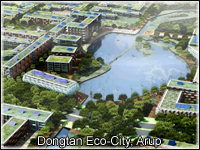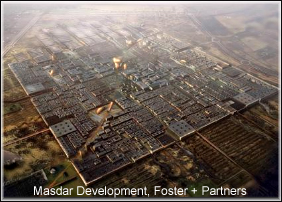Eco-Cities -- Building Better Cities for the 21st Century
 Vancouver, Canada (GLOBE-Net) – In response to the environmental challenges resulting from the unprecedented tide of urbanization worldwide, schemes to create ‘eco-cities’ have been launched in many countries. Seeking to address simultaneously a myriad of environmental issues that currently plague our cities, projects from China to the United Kingdom will showcase leading-edge technologies and urban planning. If they work they could help turn cities into more sustainable spaces.
Vancouver, Canada (GLOBE-Net) – In response to the environmental challenges resulting from the unprecedented tide of urbanization worldwide, schemes to create ‘eco-cities’ have been launched in many countries. Seeking to address simultaneously a myriad of environmental issues that currently plague our cities, projects from China to the United Kingdom will showcase leading-edge technologies and urban planning. If they work they could help turn cities into more sustainable spaces.
The year 2007 marked a turning point in human history. For the first time more than half of the world’s population live in cities and towns. By 2030 that figure will rise to two-thirds. The fastest growing cities are in the developing world, where the fastest growing neighbourhoods are slums.
It is evident that urbanization is not just a challenge for cities, but a challenge for humanity and the environment as a whole. As EU Commissioner Margot Wallström, stated recently when outlining her ‘vision’ for sustainable cities, “For the first time in history, half of the world’s population live, work, fall in love, consume and pollute in cities. So the main challenges facing humanity such as public health, economic development, poverty, energy, resource depletion, and environmental quality are urban-based. And these challenges will continue to grow as the world’s cities grow,” she added.
The good news is that many currently available technologies can greatly reduce the environmental footprint of urban dwellers by cutting energy use, improving water quality, reducing air pollution, and diverting solid wastes from landfills. But replacing aging infrastructure in cities is not only expensive, but also technically challenging. The tantalizing vision of building green cities from scratch has been around for decades - concepts embraced by politicians, urban designers and philosophers alike. The world may see its first ‘eco-city’ in the next few years, but time will tell how well these Waldenesque visions will play out.
Starting anew
The most publicized and ambitious eco-city is planned for an area near Shanghai, China. The city of Dongtan will be built on a 630-hectare island site near sensitive wetlands at the mouth of the Yangtze, Asia’s longest river. Slated to open with accommodation for 50,000 by 2010, it will support 80,000 people by 2020, with the agricultural and rural support needed to make it a self-sustaining region.
Spearheaded by the Shanghai Industrial Investment Corporation (SIIC) and designed by London’s Arup Urban Design, the planned ‘city’ will eventually support half a million people; will produce few carbon emissions; will have no landfills; and will deploy a variety of water and energy saving technologies.
Innovative design features and high density planning will encourage public transit use. Building on a “Town of Villages” approach will create localized communities that will require less energy to function. Commercial, residential and industrial neighbourhoods will be integrated as one. The city will also make extensive use of green spaces and waterways to maintain a connection to the natural environment.
An ‘energy centre’ will manage power provided by wind turbines, bio-fuels and recycled organic materials. Waste will be reused when possible, and organics will be composted or used for biomass energy. Sewage will be treated and used for irrigation and composting.
Another environmentally friendly city will be created in the oil rich region of Abu Dhabi in the United Arab Emirates. The Abu Dhabi Future Energy Company (ADFEC) has announced plans to develop a zero-waste, zero-carbon ‘city’ and clean technology cluster on a 6 million square meter plot of land. 
The city will house clean technology companies as well as a research and development institution established in cooperation with the Massachusetts Institute of Technology. Project plans include extensive renewable energy, widespread public transit, and efficient infrastructure to lure up to 1500 clean technology companies.
Billed as the ‘world’s first zero carbon city’, the development is expected to house at least 50,000 people when it opens in 2009 and as many as 100,000 eventually. UK-based architects Foster + Partners are developing master plans for the project.
The Abu Dhabi venture and the Dongtan concept have inspired others to create similar visions. London Mayor Ken Livingstone was so taken by the prospect that he travelled to Shanghai to inspect the site and has announced plans to build an eco-development in Britain, following Dongtan’s model.
Sites must be capable of supporting at least 200 homes to ensure a critical mass allowing the installation of shared energy systems and other features that will contribute to a near zero or zero carbon footprint for each new settlement. The developments will provide testing grounds for the government’s plan to build five “eco-villages” of up to 100,000 homes on old industrial sites.
Designing a city or community from the ground up requires a holistic, multi-dimensional approach that takes into account energy and land use, employment, transportation, building design, and a host of other necessities for a healthy city. Connecting all of these variables in principle will allow for the creation of compact, more liveable cities with a higher quality of life for residents and low impacts on the surrounding environment.
Making the environment a pillar in city planning
The environmental realities the world now faces dictates that ecological principles must be given higher priority by city officials and urban planning professionals. Gone are the days where zoning and transportation issues could be addressed on an ad-hoc basis. Both public and private capital investment must now be ranked on an eco-impact dimension as well as socio-economic principles.
One key feature in the ‘eco-city’ vision is the alignment of a city’s resource inputs and outputs with the supporting capacity of the surrounding environment. This includes adjacent water and air sheds, as well as the productive capacity of surrounding rural areas that are required to support the city.
The concept of using the environment to guide planning decisions was embraced early on by the Alberta town of Okotoks. In 1998, it became one of the first municipalities in the world to establish growth targets linked to infrastructure development and environmental carrying capacity when it adopted a development plan based on the carrying capacity of the Sheep River. The town’s water plan includes conservation measures, a new wastewater treatment plant, and cooperation with surrounding areas to maintain the river’s watershed.
The town’s environmental focus extends to other areas. Okotoks is home to the Drake Landing Solar Community, a master planned neighbourhood which utilizes a district energy system to store solar energy underground during the summer months and distribute the energy to each home for space heating needs during winter months. The unique community is considered a showcase project and provides a real-life example of the residential component of an eco-city.
The challenge for cities in the coming century will be enormous. Cities are living entities and as such require vast amounts of water, energy and supporting agriculture and natural resources. Densification, green building techniques and community diversity are all important considerations. Even more important are the infrastructure decisions that are being made today. They will have lasting impacts for 50 to 100 years in the future.
How we respond to the environmental challenges of urbanization will in large measure determine not only the health, quality of life and economic opportunities of upcoming generations, but also the course of human development overall. Eco-cities represent much more than an urban planner dream. They may ultimately be the key to preserving civilization as we know it.
You can return to the main Market News page, or press the Back button on your browser.

